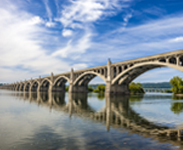
Home > Motorcycle Community > Motorcycle Helmets
A Guide to Motorcycle Helmets
Motorcycle helmets are the most effective gear for saving motorcyclists’ lives. They can significantly reduce your risk of injury or death in a crash. However, not all helmets are made the same or have the same level of protection. You need to choose a helmet that will protect your head and look good enough to make you want to wear it. This comprehensive helmet buying guide will equip you with the knowledge needed to choose the perfect helmet for your riding adventures.
Motorcycle Helmet Laws
Motorcycle helmet laws vary significantly from state to state. For instance, in New Jersey, all riders must wear a helmet while on the road. In Pennsylvania, the laws are different and allow motorcyclists who meet certain criteria ride without a helmet. It’s essential to be aware of and comply with the specific helmet laws in the state where you’re riding to ensure you’re meeting the necessary safety regulations and protecting yourself adequately.
Helmet Accessories
When it comes to accessorizing your helmet, the options are pretty diverse. Consider communicators for chatting with fellow riders while on the go. An action camera is a cool addition if you want to capture those thrilling rides and share your adventures. And for those who love a touch of personal style, decorative add-ons like cat ears, devil horns, or even ponytails are available to spice up your helmet. While these accessories don’t directly impact safety, they sure add a fun and personalized touch to your riding gear.
When to Replace a Motorcycle Helmet
Typically, helmets should be replaced every 3 to 5 years, even if they seem undamaged. The inner foam shell and lining deteriorate over time, affecting their protective capabilities. Additionally, if your helmet has been in an accident, getting a new one is essential, as its integrity might have been compromised. Even if it has endured minor mishaps like drops or bangs, it’s safer to replace it. Exposure to the elements, whether left outside or in a garage, can also expedite the materials’ degradation.
DON’T BUY USED
Steer clear of used helmets when shopping. When you buy a used helmet, there’s uncertainty about its history. You can’t be sure how it was treated or how many times it might have taken a tumble. Plus, helmets mold to the shape of the original owner’s head over time. This custom-fit might not be the right match for your own head shape, compromising the helmet’s ability to protect you effectively.
Protect Your Head With This Helmet Buying Guide
Riding a motorcycle can be exhilarating, but safety should always come first. Motorcycle helmets aren’t just accessories—they’re essential safeguards that protect your head and face in case of an accident. From full-face shields to open-face options, the right helmet can make a significant difference in minimizing injuries and saving lives. However, safety extends beyond just wearing a helmet; having motorcycle insurance is equally crucial. It ensures financial protection in case of unforeseen events on the road. Don’t compromise on safety or risk the unexpected; take the next step towards comprehensive protection by securing a motorcycle insurance quote today. Prioritizing safety on the road isn’t just a choice—it’s a responsibility.





